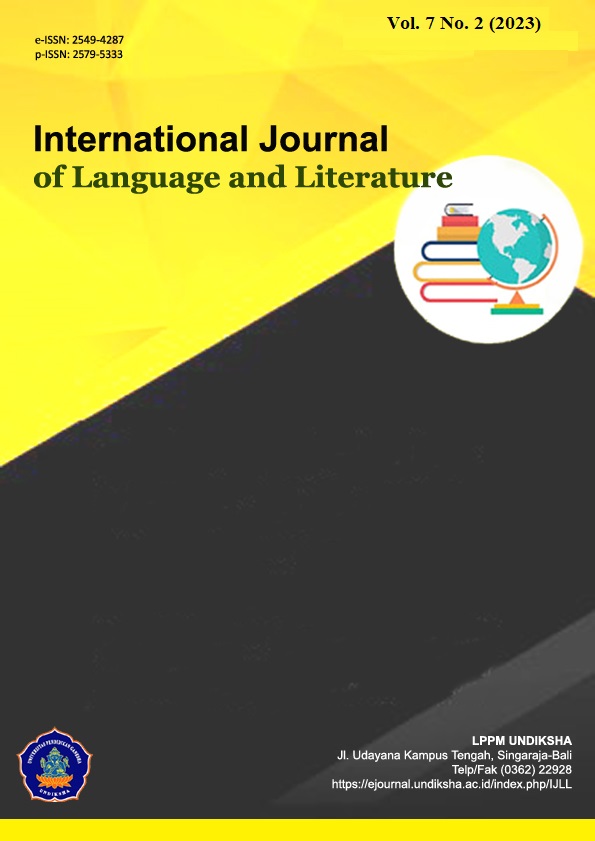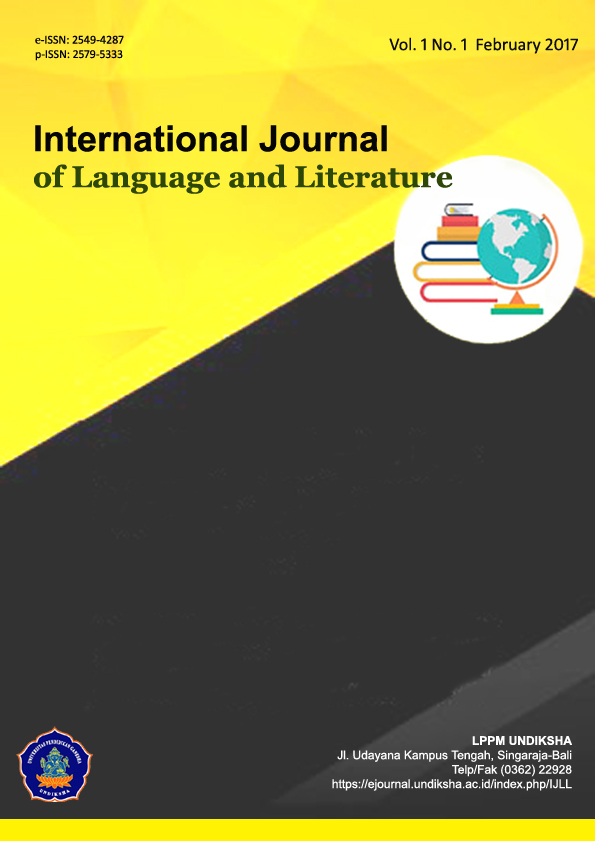Multicultural Society Reflected in Freedom Writers Movie: Sociolinguistics Approach
DOI:
https://doi.org/10.23887/ijll.v7i2.41185Keywords:
Sociocultural, Multicultural, Freedom Writers, SociolinguisticsAbstract
Sociolinguistics analysis of “Freedom Writer” movie is an analysis of the variation of language that used in society and cultural. The research objective is to analyze the differences in language styles used by multicultural society as well as to determine their relationship with the level of education and cultural backgrounds. The data source in this research is The Freedom Writers movie by Richard La Gravenese, while the data in this research are spoken dialogue that contains in the level of word pronunciation, vocabulary selection, and language errors. This research used a descriptive qualitative method. The data analysis will be in the form of observations on each selected utterance, followed by presenting the data and drawing a conclusion. The findings reveal that various groups of individuals employ different languages depending on their social standing. Some reasons contribute to these disparities. Besides from race, education level and social background are important elements in the development of a person's language patterns.
References
Abacioglu, C. S., Fischer, A. H., & Volman, M. (2022). Professional development in multicultural education: What can we learn from the Australian context? Teaching and Teacher Education, 114, 103701. https://doi.org/10.1016/j.tate.2022.103701. DOI: https://doi.org/10.1016/j.tate.2022.103701
Asrial, A., Syahrial, S., Kurniawan, D. A., Subandiyo, M., & Amalina, N. (2019). Exploring obstacles in language learning among prospective primary school teacher. International Journal of Evaluation and Research in Education, 8(2), 249–254. https://doi.org/10.11591/ijere.v8i2.16700. DOI: https://doi.org/10.11591/ijere.v8i2.16700
Bayyurt, Y. (2016). Current perspectives on sociolinguistics and English language education. The Journal of Language Teaching and Learning, 3(1), 69–78. https://dergipark.org.tr/en/pub/jltl/issue/22506/240603.
Caterine, W., Amalia, T., & Shaberina, S. G. R. (2021). Indonesian EFL learners’ ability to comprehend and produce implicature. IDEAS: Journal on English Language Teaching and Learning, Linguistics and Literature, 9(2), 128–137. https://doi.org/10.24256/ideas.v9i2.1924. DOI: https://doi.org/10.24256/ideas.v9i2.1924
Faizin, A. (2019). Sociolinguistics in Language Teaching. Mabasan, 9(2), 66–77. https://doi.org/10.26499/mab.v9i2.159. DOI: https://doi.org/10.26499/mab.v9i2.159
Fen, C., & Poh, K. (2015). A Review of Intrinsic and Extrinsic Motivations of ESL Learners. International Journal of Languages, Literature and Linguistics, 1(2), 98–105. https://doi.org/10.7763/ijlll.2015.v1.20. DOI: https://doi.org/10.7763/IJLLL.2015.V1.20
Fillmore, L. W. (1989). Language learning in social context. The view from research in second language learning. In North-Holland Linguistic Series: Linguistic Variations, 54, 277–302. https://doi.org/10.1016/B978-0-444-87144-2.50014-8. DOI: https://doi.org/10.1016/B978-0-444-87144-2.50014-8
Fitriani, M. (2017). A Sociolinguistic Analysis Of Stereotypes In Freedom Writers Movie. Sastra Inggris-Quill, 6(8), 780–786. https://journal.student.uny.ac.id/index.php/quill/article/view/9504.
George, E. J., & Mamidi, R. (2020). Conversational implicatures in English dialogue: Annotated dataset. Procedia Computer Science, 171(2019), 2316–2323. https://doi.org/10.1016/j.procs.2020.04.251. DOI: https://doi.org/10.1016/j.procs.2020.04.251
Harya, T. D. (2018). Sociolinguistics (code: code switching and code mixing). LENTERA: Jurnal Ilmiah Kependidikan, 11(1), 87–98. http://download.garuda.kemdikbud.go.id/article.php?article.
Hasbi, M. (2013). The attitudes of students from ESL and EFL countries to English. Register Journal, 6(1), 1–16. https://doi.org/10.18326/rgt.v6i1.1-16. DOI: https://doi.org/10.18326/rgt.v6i1.1-16
Hidayati, N. (2017). Appraisal analysis in freedom writers movie. EduLite: Journal of English Education, Literature and Culture, 2(1), 317–333. https://doi.org/10.30659/e.2.1.317-333. DOI: https://doi.org/10.30659/e.2.1.317-333
Khromchenko, O., & Shutilo, I. (2021). Approaches and Methods in Language Teaching. Cambridge university press. https://doi.org/10.36074/logos-28.05.2021.v2.05. DOI: https://doi.org/10.36074/logos-28.05.2021.v2.05
Koedel, C., Li, J., Springer, M. G., & Tan, L. (2017). The Impact of Performance Ratings on Job Satisfaction for Public School Teachers. American Educational Research Journal, 54(2), 241–278. https://doi.org/10.3102/0002831216687531. DOI: https://doi.org/10.3102/0002831216687531
Mahadi, T. S., & Jafari, S. M. (2012). Language an Culture. International Journal of Humanities and Social Science, 2(17), 230–235. https://www.ijhssnet.com/journals/Vol_2_No_17_September_2012/24.pdf. DOI: https://doi.org/10.1007/s12045-012-0021-z
Nur’aini, A. B., Triana, J., & Fogli, L. (2021). The Analysis of Word Formation in Movie “Wonder” and Its Application in Teaching Vocabulary. Scripta : English Department Journal, 8(2), 20–27. https://doi.org/10.37729/scripta.v8i2.702. DOI: https://doi.org/10.37729/scripta.v8i2.702
Oktaviani, Y., & Arimbi, D. A. (2015). The Representation of Female Lead Characters (Ravenna and Snow White) in Snow White and the Huntsman Film. Allusion, 4(2), 54–76. https://repository.unair.ac.id/117594/.
Ong, P. A. L. (2022). Critical multiculturalism and countering cultural hegemony through children’s literature. Waikato Journal of Education, 27(1), 51–65. https://doi.org/10.15663/wje.v26i1.884. DOI: https://doi.org/10.15663/wje.v26i1.884
Paradis, J., & Nicoladis, E. (2007). The Influence of Dominance and Sociolinguistic Context on Bilingual Preschoolers’ Language Choice. International Journal of Bilingual Education and Bilingualism, 10(3), 277–297. https://doi.org/10.2167/beb444.0. DOI: https://doi.org/10.2167/beb444.0
Pimentel, C. (2010). Critical Race Talk in Teacher Education through Movie Analysis. Multicultural Education, 17(3), 51–56. https://eric.ed.gov/?id=EJ902700.
Rifai, D. M., & Prasetyaningrum, S. T. (2016). A Sociolinguistic Analysis of Addressing Terms Used in Tangled Movie Manuscript. Jurnal Penelitian Humaniora, 17(2), 123–134. https://doi.org/10.23917/humaniora.v17i2.2504. DOI: https://doi.org/10.23917/humaniora.v17i2.2504
Rina Devianty. (2017). Bahasa Sebagai Cermin Kebudayaan. Jurnal Tarbiyah, 24(2), 226–245. https://doi.org/10.30829/tar.v24i2.167.
Salifu, N. A. (2010). Signaling Politeness, Power and Solidarity through Terms of Address in Dagbanli. Nordic Journal of African Studies, 19(4), 274–292. https://doi.org/10.53228/njas.v19i4.198.
Sancoyo, G. L. A. (2018). Analisis Substansi Pesan Edukatif Film “ Freedom Writers ” Dan Pengembangan Skenario Pembelajarannya Untuk Perkuliahan Mata.
Saputra, J., Rahmadeny, M., & Jazzawi, I. (2019). The Importance of Sociolinguistics in Foreign Language Education: A Review of Selected Paper. International Journal for Educational and Vocational Studies, 1(4), 299–303. https://doi.org/10.29103/ijevs.v1i4.1415. DOI: https://doi.org/10.29103/ijevs.v1i4.1415
Septiyanti, N., Suhatmady, B., & Asih, Y. U. (2020). The Conversational Implicature in the Movie Script of Freedom Writers. E3L: Journal of English Teaching, Linguistic, and Literature, 3(2), 55–66. https://jurnal.fkip.unmul.ac.id/index.php/e3l/article/view/1964.
Setiawan, B., & Wardhani, N. E. (2022). Multicultural Understanding Of Students In The Writing Of Indonesian Language Papers In The Era Of The Covid-19 Pandemic. International Conference Of Humanities And Social Science (ICHSS), 1(1), 209–217. https://doi.org/10.1234/ichss.v1i1.26.
Shilfani, S., Taula’bi’, N., Sudarsi, E. T., Girik Allo, M. D., & Kristanto, K. (2022). The Learning of Toraja Language Variations: The Students’ Attitudes, Attendance, Activity Change, and Learning outcomes in Ke’te’ Kesu’ Toraja Tourism Site Context. JPI (Jurnal Pendidikan Indonesia), 11(1), 19–26. https://doi.org/10.23887/jpi-undiksha.v11i1.28622. DOI: https://doi.org/10.23887/jpi-undiksha.v11i1.28622
Silaban, H. S., & Afriana, A. (2020). Address Form Analysis in the Movie “Mortdecai.” Linguistic, English Education and Art (LEEA) Journal, 4(1), 25–33. https://doi.org/10.31539/leea.v4i1.1391. DOI: https://doi.org/10.31539/leea.v4i1.1391
Stewart, D.-L. (2022). Performing goodness in qualitative research methods. International Journal of Qualitative Studies in Education, 35(1), 58–70. https://doi.org/10.1080/09518398.2021.1962560. DOI: https://doi.org/10.1080/09518398.2021.1962560
Syahidawati, N. M. N., & Parmawati, A. (2020). a Sociolinguistics Analysis of Adressing Term Used in Aisyah: Biarkan Kami Bersaudara Movie. PROJECT (Professional Journal of English Education), 3(3), 354. https://doi.org/10.22460/project.v3i3.p354-358. DOI: https://doi.org/10.22460/project.v3i3.p354-358
Wahyuningsih, S. (2018). Men and Women Differences in Using Language: A Case Study of Students at Stain Kudus. EduLite: Journal of English Education, Literature and Culture, 3(1), 79–90. https://doi.org/10.30659/e.3.1.79-90. DOI: https://doi.org/10.30659/e.3.1.79-90
Yang, X. (2010). Address Forms of English: Rules and Variations. Journal of Language Teaching and Research, 1(5), 743–745. https://doi.org/10.4304/jltr.1.5.743-745. DOI: https://doi.org/10.4304/jltr.1.5.743-745
Zavitri, I., Machmoed, H., & Sukmawaty, S. (2018). the Address Terms in English and Selayerese: a Sociolinguistic Perspective. Jurnal Ilmu Budaya, 6(1), 129–134. https://doi.org/10.34050/jib.v6i1.4317. DOI: https://doi.org/10.34050/jib.v6i1.4317
Downloads
Published
How to Cite
Issue
Section
License
Copyright (c) 2023 International Journal of Language and Literature

This work is licensed under a Creative Commons Attribution-ShareAlike 4.0 International License.
IJLL Journal provides immediate open access to its content on the principle that making research freely available to the public to supports a greater global exchange of knowledge.

This work is licensed under a Creative Commons Attribution-ShareAlike 4.0 International License








